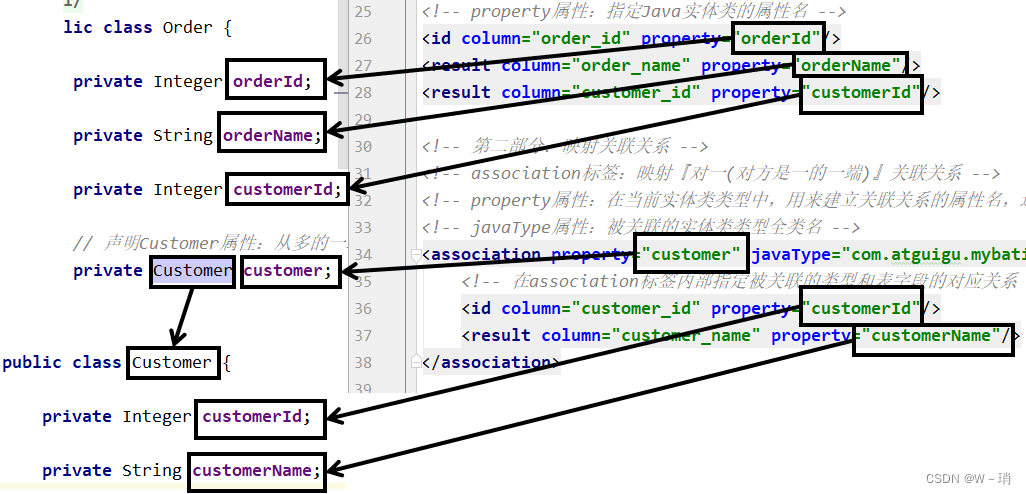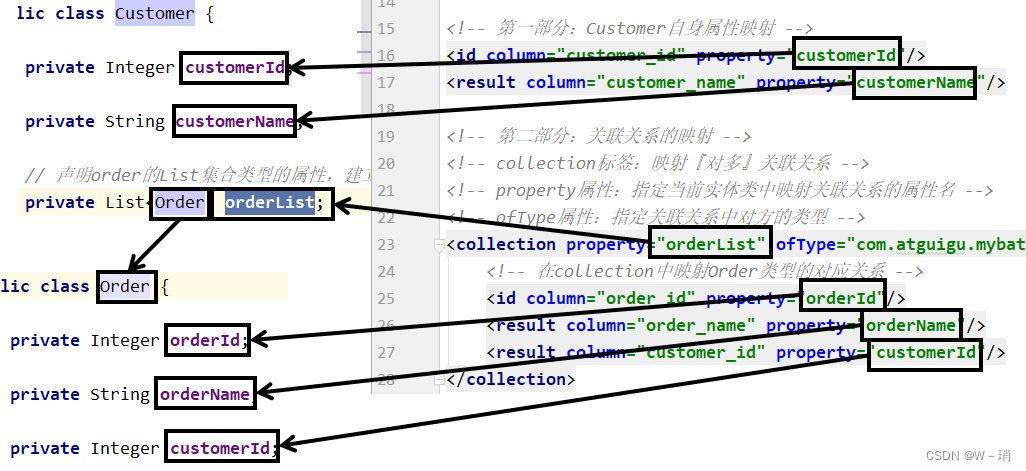目录
1.对一映射
2.对多映射
3.多表映射总结
1)多表映射优化
- 对一:属性中包含对方对象
- 对多:属性中包含对方对象集合
1.对一映射
需求:根据ID查询订单,以及订单关联的用户的信息!
<!-- 创建resultMap实现“对一”关联关系映射 -->
<!-- id属性:通常设置为这个resultMap所服务的那条SQL语句的id加上“ResultMap” -->
<!-- type属性:要设置为这个resultMap所服务的那条SQL语句最终要返回的类型 -->
<resultMap id="selectOrderWithCustomerResultMap" type="order">
<!-- 先设置Order自身属性和字段的对应关系 -->
<id column="order_id" property="orderId"/>
<result column="order_name" property="orderName"/>
<!-- 使用association标签配置“对一”关联关系 -->
<!-- property属性:在Order类中对一的一端进行引用时使用的属性名 -->
<!-- javaType属性:一的一端类的全类名 -->
<association property="customer" javaType="customer">
<!-- 配置Customer类的属性和字段名之间的对应关系 -->
<id column="customer_id" property="customerId"/>
<result column="customer_name" property="customerName"/>
</association>
</resultMap>
<!-- Order selectOrderWithCustomer(Integer orderId); -->
<select id="selectOrderWithCustomer" resultMap="selectOrderWithCustomerResultMap">
SELECT order_id,order_name,c.customer_id,customer_name
FROM t_order o
LEFT JOIN t_customer c
ON o.customer_id=c.customer_id
WHERE o.order_id=#{orderId}
</select>
对应关系:

关键词:
在“对一”关联关系中,我们的配置比较多,但是关键词就只有:association和javaType
2.对多映射
需求:查询客户和客户关联的订单信息!
<!-- 配置resultMap实现从Customer到OrderList的“对多”关联关系 -->
<resultMap id="selectCustomerWithOrderListResultMap"
type="customer">
<!-- 映射Customer本身的属性 -->
<id column="customer_id" property="customerId"/>
<result column="customer_name" property="customerName"/>
<!-- collection标签:映射“对多”的关联关系 -->
<!-- property属性:在Customer类中,关联“多”的一端的属性名 -->
<!-- ofType属性:集合属性中元素的类型 -->
<collection property="orderList" ofType="order">
<!-- 映射Order的属性 -->
<id column="order_id" property="orderId"/>
<result column="order_name" property="orderName"/>
</collection>
</resultMap>
<!-- Customer selectCustomerWithOrderList(Integer customerId); -->
<select id="selectCustomerWithOrderList" resultMap="selectCustomerWithOrderListResultMap">
SELECT c.customer_id,c.customer_name,o.order_id,o.order_name
FROM t_customer c
LEFT JOIN t_order o
ON c.customer_id=o.customer_id
WHERE c.customer_id=#{customerId}
</select>
对应关系:

关键词:
在“对多”关联关系中,同样有很多配置,但是提炼出来最关键的就是:“collection”和“ofType”
3.多表映射总结
1)多表映射优化

我们可以将autoMappingBehavior设置为full,进行多表resultMap映射的时候,可以省略符合列和属性命名映射规则(列名=属性名,或者开启驼峰映射也可以自定映射)的result标签!
修改mybati-sconfig.xml:
<!--开启resultMap自动映射 -->
<setting name="autoMappingBehavior" value="FULL"/>
修改teacherMapper.xml
<resultMap id="teacherMap" type="teacher">
<id property="tId" column="t_id" />
<!-- 开启自动映射,并且开启驼峰式支持!可以省略 result!-->
<!-- <result property="tName" column="t_name" />-->
<collection property="students" ofType="student" >
<id property="sId" column="s_id" />
<!-- <result property="sName" column="s_name" />-->
</collection>
</resultMap>
2)多表映射总结





